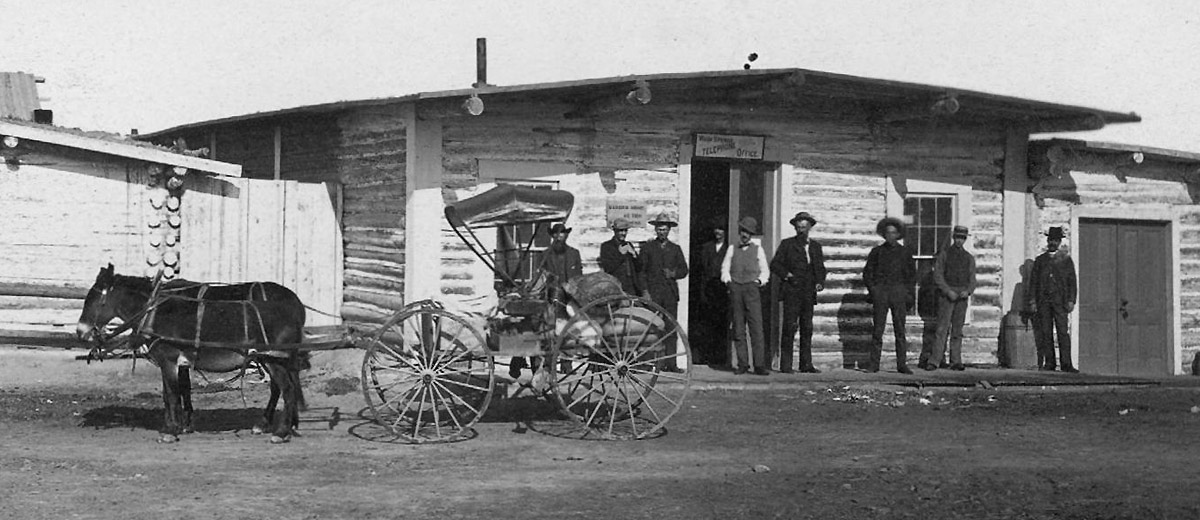
This location has transitioned over 145 years from its unique beginning as a log store, to the Saratoga Hot Springs Hotel, then the State Hot Springs Reserve, and later the Saratoga Inn until it was ultimately purchased by world-renowned surgeon, Michael Janssen, who frequently visited the area as a favorite getaway. Today it is now known as Wyoming’s premier mineral hot springs and spa destination, the Saratoga Hot Springs Resort.
History of the Healing Waters and the Saratoga Hot Springs Resort
Special thanks to Dick Perue of Historical Reproductions by Perue for photographs and historical content.
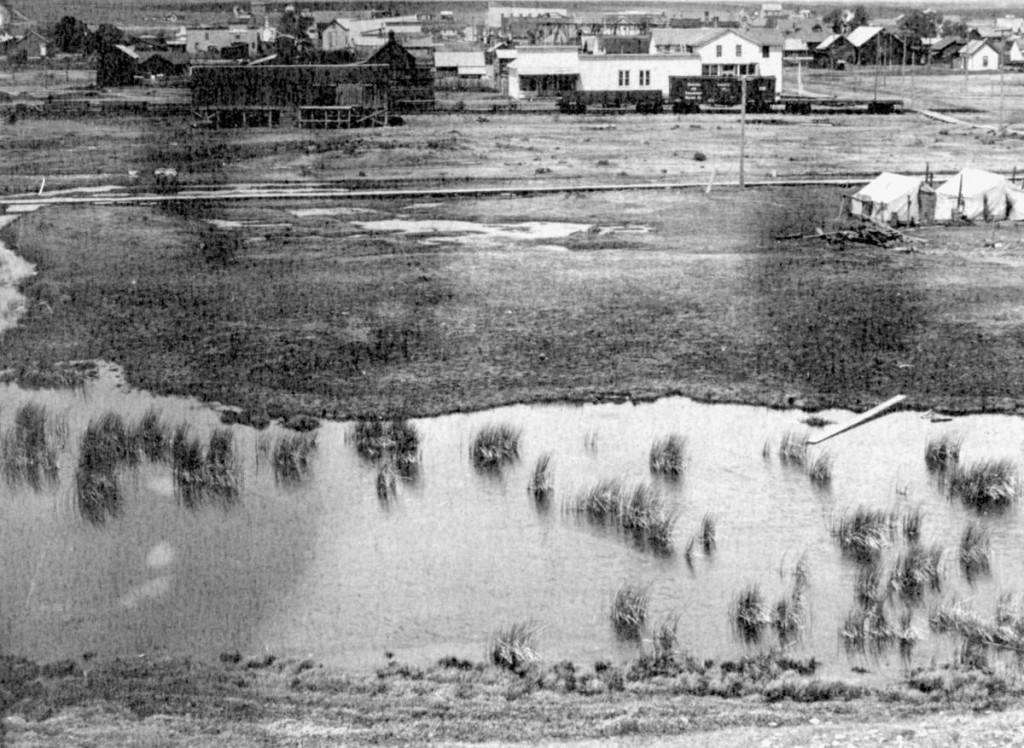
The Place of Magic Waters
Originally, the land around the natural springs was neutral ground between Native American tribes (Cheyenne, Ute and Arapaho), who frequented this area to soak in the healing waters. They called it the “place of magic waters.”
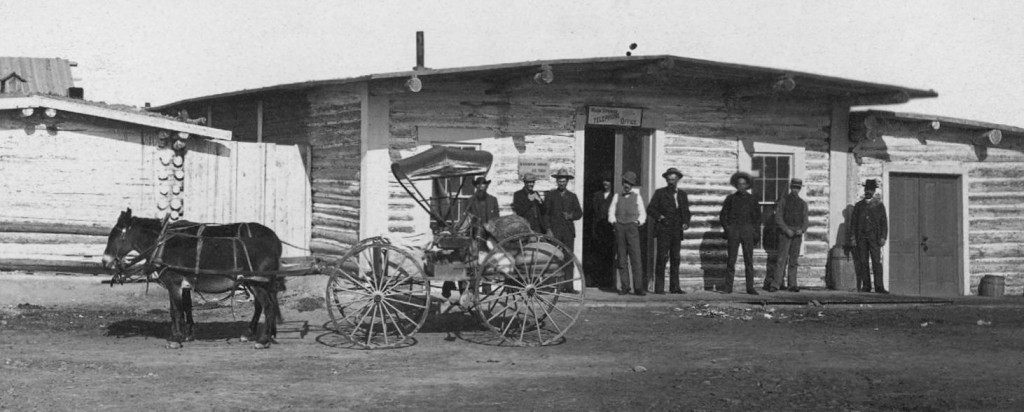
This early 1880s photograph is the only know picture which shows the name of “Warm Springs”, which appears above the open door. The log structure was later burned to the ground in 1950 to make room for the Saratoga Inn Saloon.
Pictured on the right is probably the first building erected in 1877 on the present site of the Saratoga Inn. Saratoga was first called Warm Springs and this is the only known photo with that name.
The log building was the first post office, community center, general store, saloon, gambling hall, watering hole, and the best place to get a hot bath with mineral water from the springs.
Explorers, trappers, fur traders and early settlers were the next to arrive, mainly in search of a hot bath from the mineral hot springs. The Hugus and Chatterton log store was the first building in Warm Springs, Wyoming. It originally occupied the place that is now the Saratoga Resort and Spa.
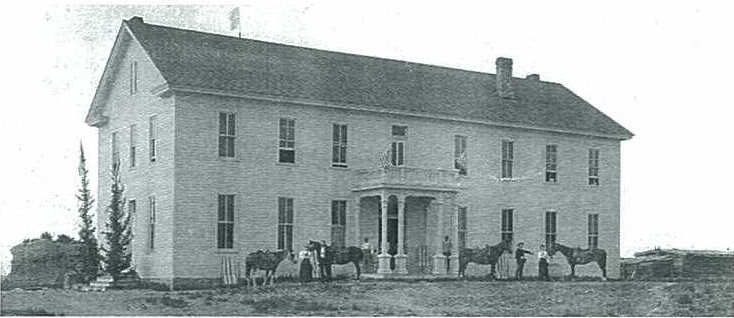
The large rock to the left is now the No. 1 golf tee. The log store is shown on the far right.
The town of Warm Springs was renamed Saratoga with the hopes of creating a smaller version of the famed New York spa town, Saratoga Springs.
In the spring of 1884, the Saratoga House, later known as the Saratoga Hot Springs Hotel, was built by owners William H. Cadwell and Judge M.E. Hooker. Overlooking the Upper North Platte River, the 2-story hotel boasted a large 60-person dining room, hotel office, barbershop, billiard room, drug store and a ladies reception room. A wide hall and stairway, with exquisite black walnut banisters, led to sleeping rooms furnished in the style of the era.
Visitors, military officers from nearby Fort Steele, local ranch families and sportsmen from the east coast and Great Britain traveled to Saratoga to experience the renowned therapeutic hot mineral waters. The hotel operated successfully until April 1902, when it caught fire and burned to the ground.
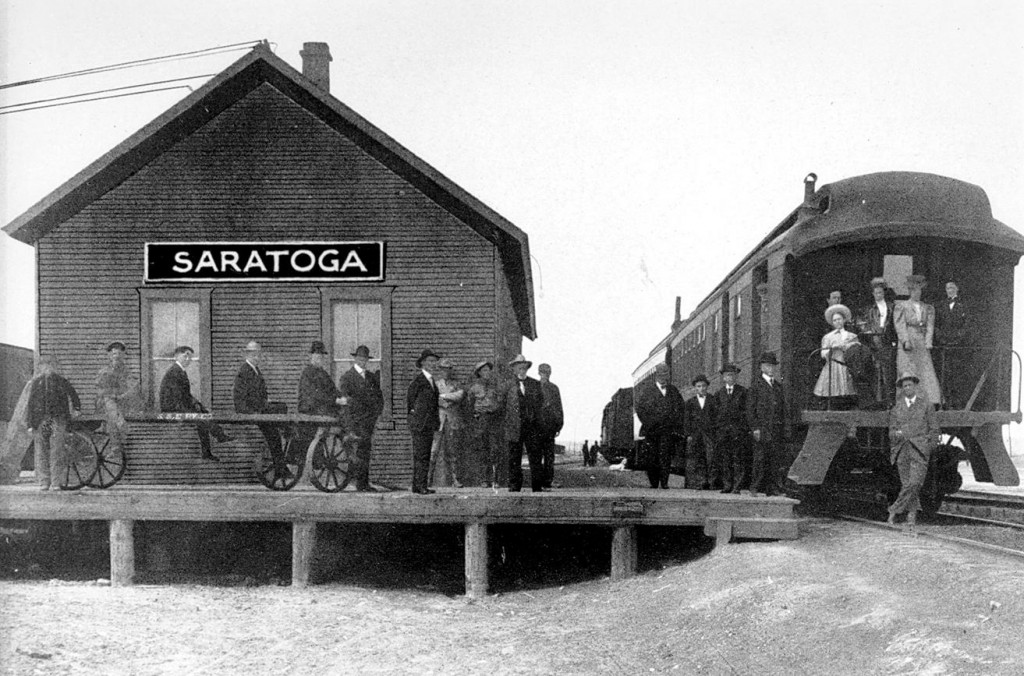
Passengers at the Saratoga depot of the Saratoga & Encampment Railway Company. The depot was built in 1915. It was moved in the 1970’s by the Saratoga Historical & Cultural Association and now houses the Saratoga Museum.
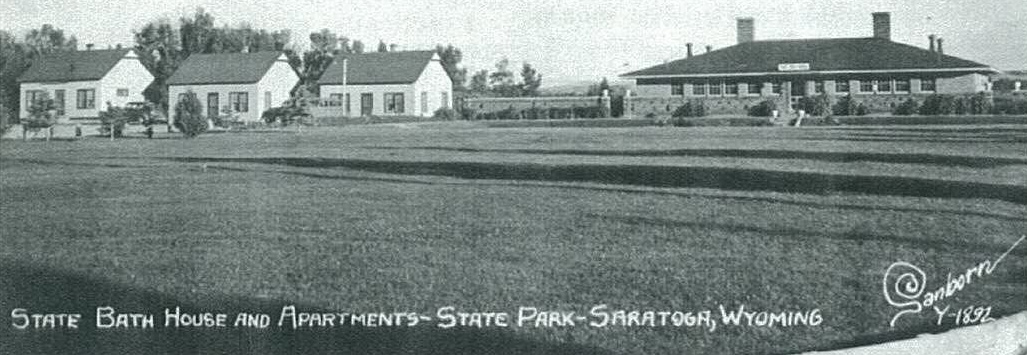
The first railroad locomotive arrived in Saratoga on May 19, 1907. At that time, passenger fare to ride in a boxcar from Walcott to Saratoga was $1.25 and the minimum freight charge was 50 cents.
According the Saratoga Sun newspaper, 35 to 50 passengers rode the train “each way every day.”
After the unfortunate demise of the Saratoga Hot Springs Hotel, several other structures were erected around the mineral hot springs. In 1921, the State of Wyoming purchased the 420-acre site and established the “Saratoga Hot Springs State Reserve”. The State Bath House, which now houses the Healing Waters Spa, was constructed along with swimming pools on each side of the bath house. Use of the private State Baths was offered to travelers for 50 cents for a dip in the hot mineral water. Also offered to those weary travelers were sweat baths and Swedish massage.
The mineral springs were hailed as a Fountain of Health.
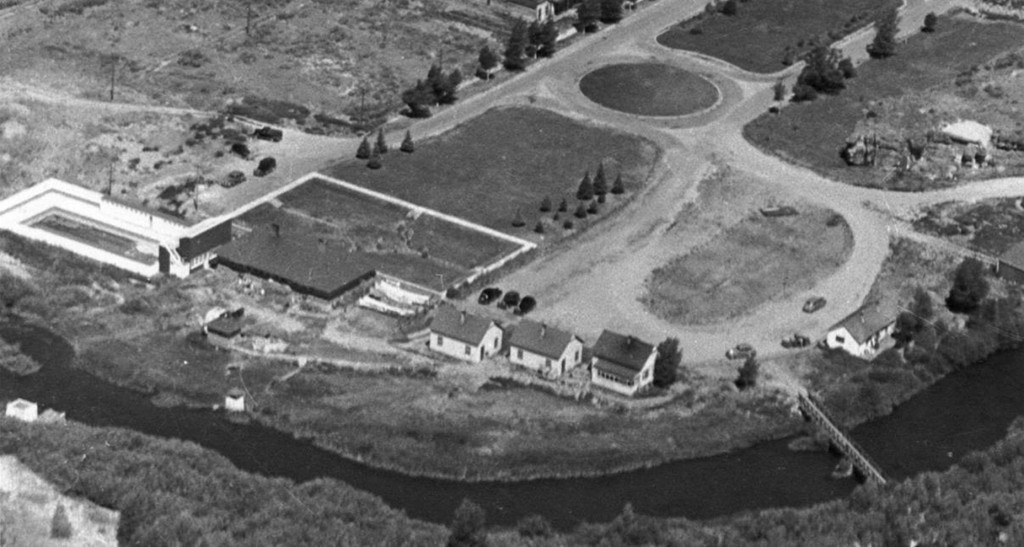
This 1940’s aerial photo by Saratoga Sun editor and publisher Bob Martin shows the famous mineral hot springs and Saratoga State Park property. The facility included the brick bath house, two swimming pools—left and right of bath house—four living quarters and several maintenance shops.
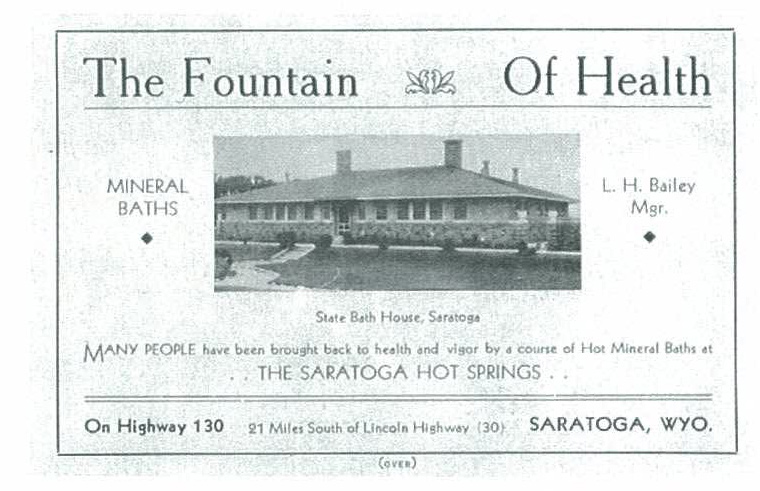
Health and pleasure seekers will find the Saratoga Hot Springs a most desirable place for an outing or a restful vacation, as well as a real Fountain of Health, for those afflicted with rheumatism, neuritis, blood and skin diseases, and kindred ailments”, expounds a 1930’s advertisement for the State Bath House in the Saratoga Hot Springs State Park.

The brick bath house (right) was built by the State of Wyoming in 1923 as the first improvement to the Saratoga State Park. Early bath tubs were constructed of lumber, which were later replaced by stone tubs. When porcelain tubs were installed, the bath house became ultra-modern. Apartments to house park visitors and personnel are on the left. Two cottages remain today as private homes while the third was moved to a local ranch.
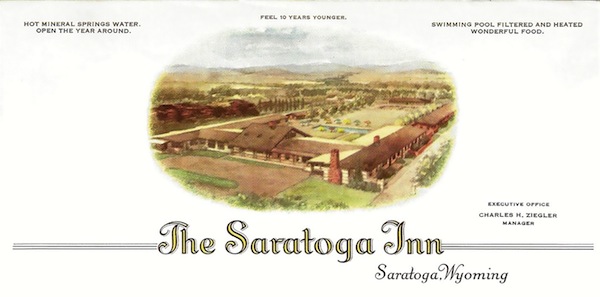
This is the architect’s drawing of the Saratoga Inn as it would appear when the extensive development project by the Saratoga Hotel Company is completed and the resort is ready for full-scale operation. The plan includes a new hotel, swimming pool, sunken garden and 9-hole golf course. The state cottages and bath house are to remain in use, all built around the famous mineral hot springs.
In 1949, visionary Bill Walker, of the Saratoga Hotel Company, leased 404 acres of the Saratoga Hot Springs Reserve, under a 99-year lease and construction of the Saratoga Inn begins. “This place has everything, hot springs (to heal) close to anything that ails you, fishing, hunting, duck and pheasant shooting, one of the most colorful cow towns anywhere, red desert, timber and mountain country all in one,” noted Bill Walker.”
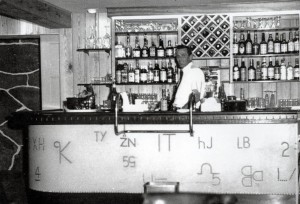
Under 1949 Wyoming Law, serving liquor on state property was prohibited. Since the Saratoga Inn was built on land leased from the state, it was necessary to acquire private property adjacent to the Inn. The town’s first structure, the log store, was burned to the ground and replaced with the bar. The leather bar with local brands was built by local leather craftsman, inventor, rancher and businessman Roy Welton (pictured, left).
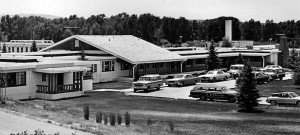 In the summer of 1950, the Saratoga Hotel Company completed construction of the Saratoga Inn–a modern one-story resort, which featured a main entrance with lobby, dining room, kitchen, east and west wings with several sleeping rooms, modern suites, a barber and beauty shop space, a swimming pool and sunken gardens in the center courtyard. The allure of the Wild West and the desire to be pampered at the luxurious Saratoga Inn drew the wealthy from near and far.
In the summer of 1950, the Saratoga Hotel Company completed construction of the Saratoga Inn–a modern one-story resort, which featured a main entrance with lobby, dining room, kitchen, east and west wings with several sleeping rooms, modern suites, a barber and beauty shop space, a swimming pool and sunken gardens in the center courtyard. The allure of the Wild West and the desire to be pampered at the luxurious Saratoga Inn drew the wealthy from near and far.
The photo, right, is the Saratoga Inn shortly after its opening June 15, 1950. Of modern one-story construction, the Inn contained 23 individual outside sleeping rooms and several two and four-room suites in the main lodge. All are luxuriously furnished with fully carpeted floors and twin beds, individual showers and baths. It cost $200,000 to build, according to “The Saratoga Sun” weekly newspaper.
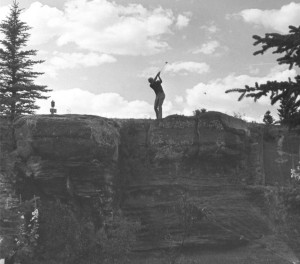
Trees now obscure big rock in photo at left. Holes number 1 and 9 at the course were built in 1955, with rest of course completed in 1958.
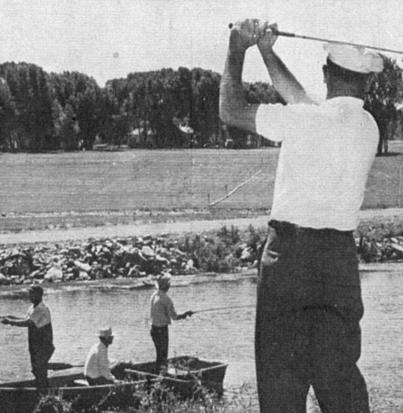
The 9-hole golf course at the Inn crosses the Upper North Platte River twice and the Cadwell Slough once as shown in photo from No. 1 tee box
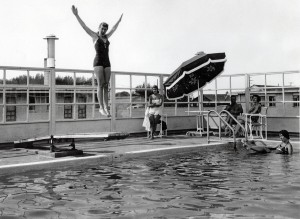
According to an early brochure, “The purpose of the Inn is to provide the valley with . . . a glass enclosed swimming pool heated with waters of mineral hot springs, . . . .
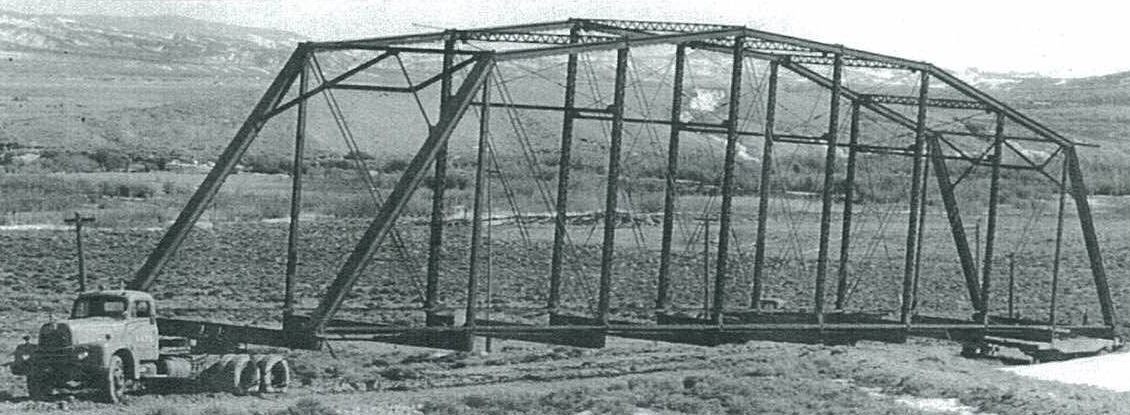 In 1956 “Pic” Walker, brother of Bill Walker, had the Snowy Range Hwy. 130 bridge moved intact from Cow Creek landing to North Platte River crossing at No. 2 tee box at the Saratoga Inn. It was transported 10 miles north along railroad tracks. See plaques on bridge.
In 1956 “Pic” Walker, brother of Bill Walker, had the Snowy Range Hwy. 130 bridge moved intact from Cow Creek landing to North Platte River crossing at No. 2 tee box at the Saratoga Inn. It was transported 10 miles north along railroad tracks. See plaques on bridge.
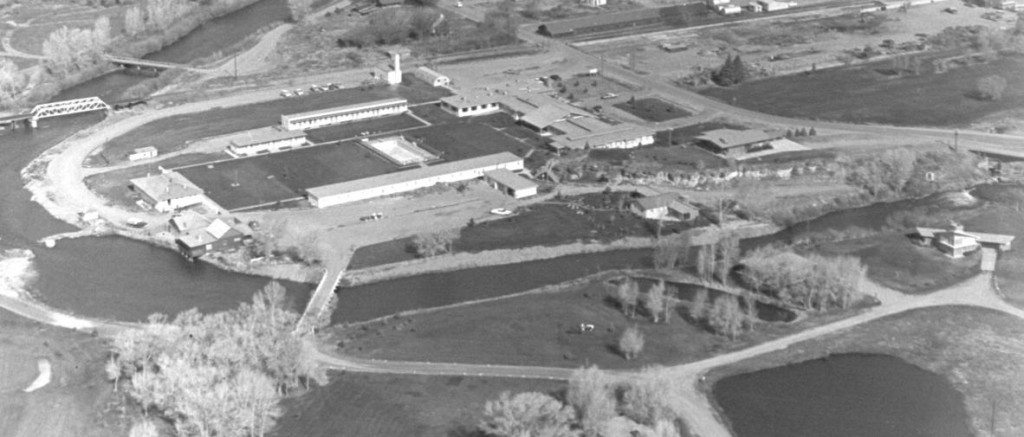
Aerial view of the Saratoga Inn taken by Dick Perue in the 1960’s which shows the hotel and units, swimming pool, bath house, state cottages, part of holes number one and nine of the golf course, driving range, private homes and building sites, and surrounding land.
The Saratoga Inn becomes privately owned. After a lengthy court dispute with Carbon County over taxes on improvements made on State-leased property, the State then decides to sell 404 acres of the Hot Springs Reserve to Bill Walker and his investors for $18,000–plus $20,000 in back taxes.
(The remaining 16 acres of the Hot Springs Reserve are given to the Town of Saratoga so that they remain open and free forever, under transfer of deed.)
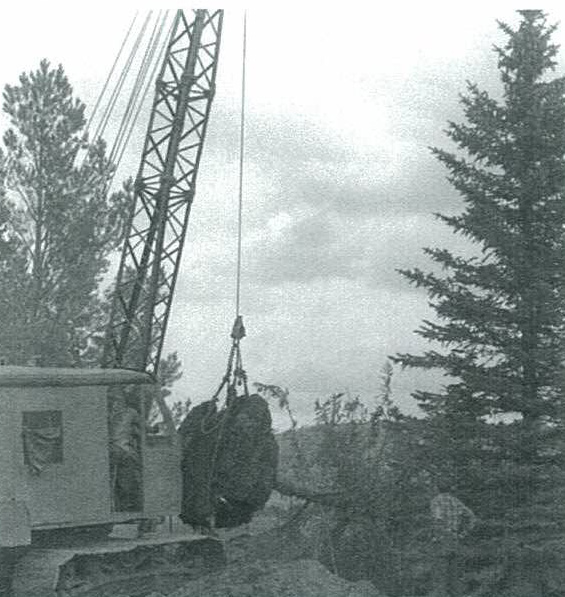 An often asked question at the Inn is “how did those evergreens get so big in 50 years.” The answer was found in the April 23, 1959 issue of “The Saratoga Sun” that states, “Tree-Moving Project Under Way in Front of Saratoga Inn. A sizeable moving job got underway… when work of relocating eight of the huge 30-year-old spruce trees in the parkway on the north side of the road in front of the Inn was started.
An often asked question at the Inn is “how did those evergreens get so big in 50 years.” The answer was found in the April 23, 1959 issue of “The Saratoga Sun” that states, “Tree-Moving Project Under Way in Front of Saratoga Inn. A sizeable moving job got underway… when work of relocating eight of the huge 30-year-old spruce trees in the parkway on the north side of the road in front of the Inn was started.
According to Manager Bill Walker… the work is being done to clear needed space for the Inn’s golf driving range.” The trees were originally planted as seedlings on the State Park property in 1928. The Dick Perue photo at left shows the trees being moved to in front of the Inn.
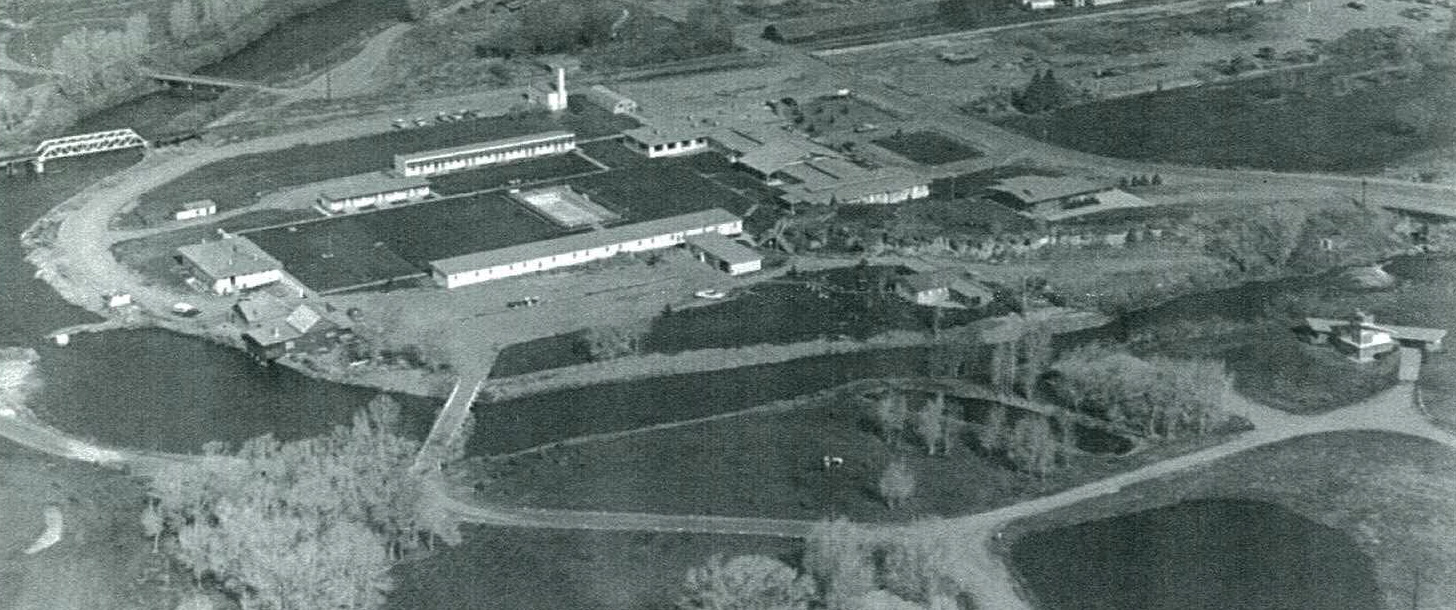
Photo by Dick Perue, Historical Reproductions by Perue.
Aerial view of the Saratoga Inn in the 1960’s which shows the hotel and units, swimming pool, bath house, state cottages, Bob Randall’s house (far right), part of holes number one and nine of the golf course, driving range, home of Sneed Davis (right center) and surrounding land.
- Investors from Phoenix
- Charlie O’Toole and associates from Colorado and Wyoming (1964)
- Cotter Ferguson
- Norm Palm and a group of local ranchers and businessmen (late 1970’s)
- Bill White & Bill Seaburg, realtors from Denver (1985-1989)
- Jim Maxwell (1989 to 1992)
- John Hamilton (1992-2002)
Major renovations during this time include five new hot mineral baths, three river rock fireplaces, remodeling of the swimming pool, converting the old State Bath House into the Healing Waters Spa, new roofs, installing central air conditioning, and a new microbrewery. - David Schumaker (2002-2008)
- International Resort Properties (2008 to present).”
In December of 2008, the International Resort Properties (the Janssen Family) acquired the Saratoga Inn and transitioned it into a four-season Wyoming resort: The Saratoga Resort and Spa. During the next six years, more resources are invested in the Resort than in the entire history of the Resort. Renovations and additions include:
- Upgraded Irrigation System for the Golf Course and Driving Range
- Reopening of the Snowy Mountain Brewery
- Room Renovation
- New Executive Chefs for on-site restaurant & pub
- Remodeling the Healing Waters Spa to include a Fitness Center
- Updates to the Sports Court and the addition of a Sports Center
- Becoming first non-smoking lodging/dining establishment in Saratoga
- Offering ATV, Jeep and Snowmobile Rentals
- Adding a Wedding Gazebo and Outdoor Terrace to the courtyard
- New flooring, lighting and a breakfast bar in Silver Saddle Room
- Housing for Employees
- Maintenance shop
- Dog Kennels for guests traveling with pets
- Decks resurfaced around teepees to include fire ring with benches
An Authentic Western Experience
Although the Resort has undergone extensive remodeling from the early years, many aspects of the original plan and construction remain, including the original gneiss rock wall in the lobby and banquet rooms and the barn wood throughout the main lodge originating from the old rodeo grounds. With the exception of the seven luxury suites, the lodge rooms remain their original size and are furnished for maximum comfort and warm decor. Guests frequently comment about the quaintness of the lodge rooms and the level of intimate comfort they provide.
We hope the Saratoga Hot Springs Resort will become a special place for each of our guests as we continue to write its history.
